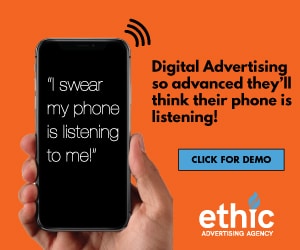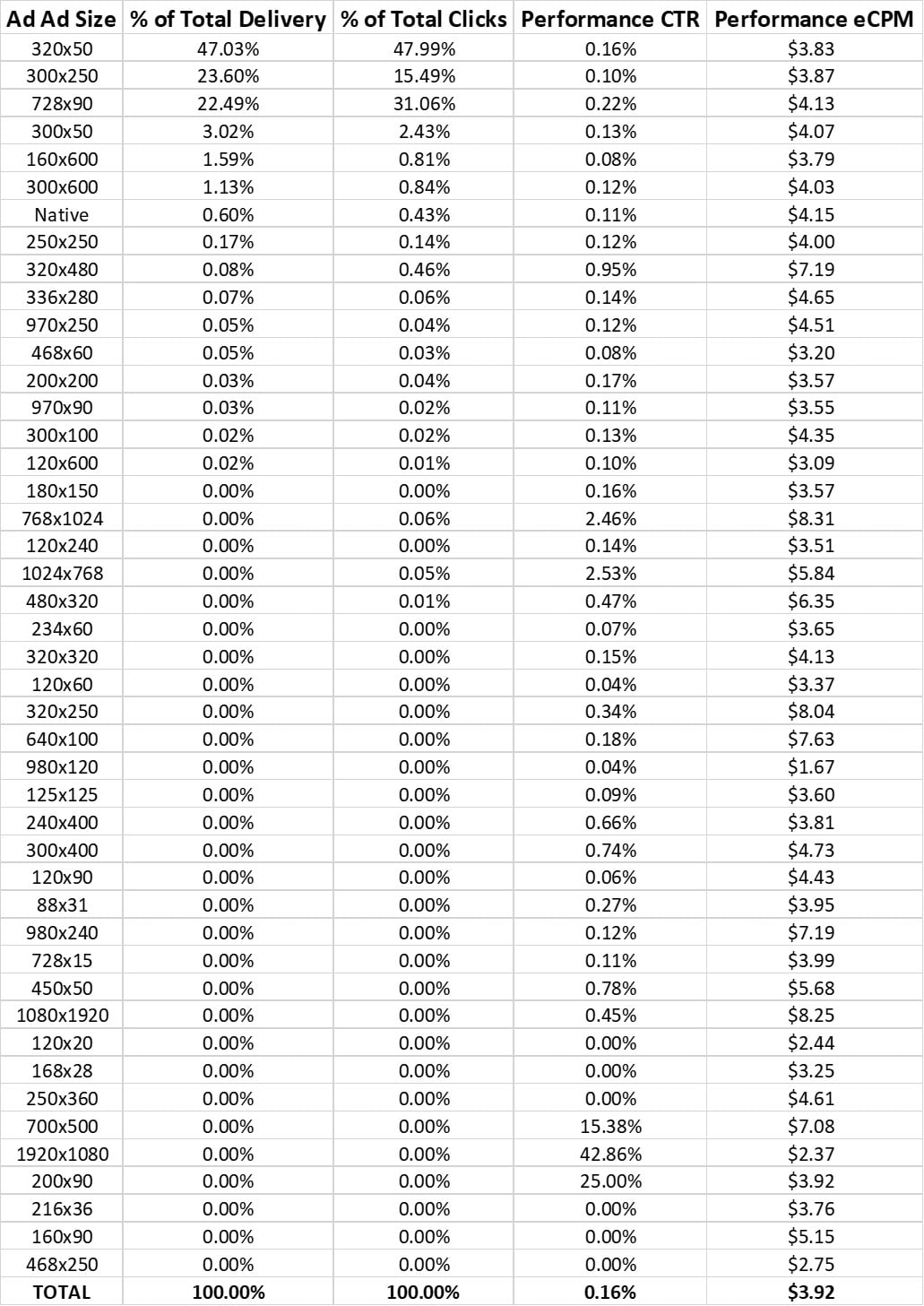Why Use Multiple Banner Sizes in Programmatic Display Advertising?
Creating digital banner ads (AKA display ads) is an art form that can quickly feel like a chore because of the all the potential ad sizes that you can create. So, why is it important to create multiple display ad sizes?
On average, different ad sizes deliver results in different way! There are great variations in the amount of inventory of each ad size, the types of devices and platforms each ad can appear on, and a size’s average Key Performance Indicator (KPI) (Click Through Rate (CTR) and Cost Per Thousand (CPM)).
Understanding Inventory

In a collaboration with our Demand Side Platform (DSP) partner, Simpli.fi, we looked at 54 banner ad sizes’ delivery and performance over a 60-day period. (Source: Simpli.fi & Ethic Advertising Agency, 2020). The ad size that had the most inventory and delivered the most impressions was a mobile optimal ad in the size of 320×50. 47.0298% of the delivered impressions fell under a 320×50 ad size.
Therefore, if you only create one ad size for your campaign, you will end up missing out on over 50% of the available inventory automatically. In the rules of supply and demand, with a smaller supply…your demand/cost will increase.
The next two closest ads were 300×250 (23.5967%) and 728×90 (22.4889%). Using these top three sizes will grant access to an estimated 93.1154% of online banner ad inventory. If you want to cover even more ground, add in 300×50, 160×600, and 300×600, and that percentage grows to 98.8547%.
Data is based on 60-day period on Simpli.fi’s DSP. Length of time and different DSPs may produce different results.
Performance

Great! So just pick the top 3-6 ad sizes based on inventory and you are in good shape, right? Essentially yes… you are in good shape, but if you want to maximize results, it’s good to pay attention to the performance of the different ad sizes. Click Through Rate (CTR) and Cost Per Thousand (CPM) are important data points and extremely useful in determining your campaign’s ad size mix.
Clicks
Let’s say clicks are the most important KPI to your campaign. The top 6 ads by inventory average between 0.08% and 0.22% CTR in our study, but what about some of the other sizes? A 320×480 ad only accounted for 0.0760% of the delivered impressions, but it averaged a 0.95% CTR. A 768×1024 ad only delivered 0.0040% of the inventory, but got a whopping 2.53% average CTR. Including ad sizes with higher than average CTR will help increase the overall clicks. You can also remove any sizes that are averaging lower than the rest. For example, the 160×600 ad that averaged 0.08% CTR
Impressions
But what if impressions and eyeballs are your main focus for the campaign? Clicks are nice, but you really just want to maximize the reach and frequency. Well, different ad sizes average different CPMs. The top 6 ads by inventory averaged between $3.78 and $4.13 gross CPMs. The lowest CPM in this study was a 980×120 ad at $1.67 gross CPM, and the highest was the 768×1024 at $8.31 gross CPM. The 768×1024 is a great example of paying a premium CPM for a premium CTR (2.53%). Using this historical CPM data, you can find mixes of ad sizes to get the optimal CPM for your campaign. Same goes for CTR data and clicks. At Ethic Advertising Agency, we like to find the balance between both and often optimize the delivery of ad sizes throughout the lifetime of a campaign.
Devices and Program Locations

The reason why there are different ad sizes is that these sizes exist for different apps, websites, and devices, so they appear and fit the screen appropriately. The top inventory ad size of 320×50 is made primarily for mobile devices and most of its inventory exists there. A 300×250 can exist on mobile and desktop, but a 300×600 for example mainly appears on larger devices.
People use multiple devices every day between their phones, tablets, and computers. Creating multiple ad sizes increases a campaign’s probability of getting your message in front of the right target audience at the right time.
This is extremely important when you are using hyper-targeted strategies. For example, let’s say someone is searching for your type of product or service online and ends up on a page that serves a 300×600, 300×250, and 728×90 ad. You only created a 320×50 ad though. You won’t be able to get your message in front of that person during an optimal opportunity.
Summary
Creating multiple display ad sizes for a programmatic digital advertising campaign allows you to do the following:
- Take advantage of more inventory
- Decrease CPMs
- Increase CTRs
- Better ensures you reach the right people at the right time

60 Day Data Summary Report

(2020, Simpli.fi & Ethic Advertising Agency)
Author: Jeff Swartz, President & Founder
8/3/2020
